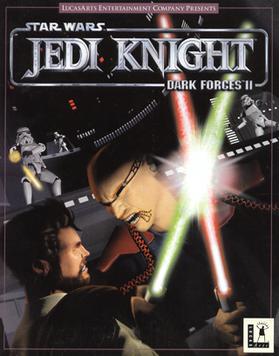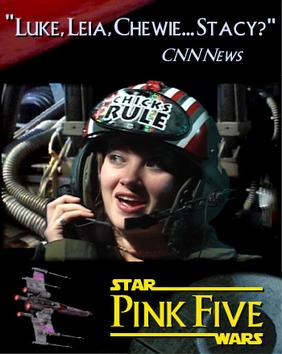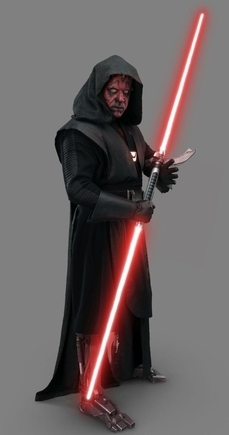Related Research Articles

Star Wars is an American epic space opera media franchise created by George Lucas, which began with the eponymous 1977 film and quickly became a worldwide pop culture phenomenon. The franchise has been expanded into various films and other media, including television series, video games, novels, comic books, theme park attractions, and themed areas, comprising an all-encompassing fictional universe. Star Wars is one of the highest-grossing media franchises of all time.

Star Wars: Episode I – The Phantom Menace is a 1999 American epic space opera film written and directed by George Lucas in his first directorial effort since 1977. The film stars Liam Neeson, Ewan McGregor, Natalie Portman, Jake Lloyd, Ahmed Best, Ian McDiarmid, Anthony Daniels, Kenny Baker, Pernilla August, and Frank Oz. It is the fourth film in the Star Wars film series, the first film of the prequel trilogy and the first chronological chapter of the "Skywalker Saga". Set 32 years before the original trilogy, during the era of the Galactic Republic, the plot follows Jedi Master Qui-Gon Jinn and his apprentice Obi-Wan Kenobi as they try to protect Queen Padmé Amidala of Naboo in hopes of securing a peaceful end to an interplanetary trade dispute. Joined by Anakin Skywalker—a young slave with unusually strong natural powers of the Force—they simultaneously contend with the mysterious return of the Sith. The film was produced by Lucasfilm and distributed by 20th Century Fox.

Luke Skywalker is a fictional character in the Star Wars franchise. He was introduced in the original film trilogy and also appears in the sequel trilogy. Raised as a moisture farmer on the planet Tatooine, Luke joins the Rebel Alliance and becomes a pivotal figure in the struggle against the Galactic Empire. He trains as a Jedi under Obi-Wan Kenobi and Yoda, and eventually confronts his father, the Sith Lord Darth Vader. Years later, Luke trains his nephew Ben Solo and mentors the scavenger Rey. Luke is the twin brother of Leia Organa.

Star Wars: Episode III – Revenge of the Sith is a 2005 American epic space opera film that is the sequel to The Phantom Menace (1999) and Attack of the Clones (2002). It is the sixth film in the Star Wars film series, the third installment in the Star Wars prequel trilogy, and third chronological chapter of the "Skywalker Saga". It is written and directed by George Lucas, who also served as executive producer. The film stars Ewan McGregor, Natalie Portman, Hayden Christensen, Ian McDiarmid, Samuel L. Jackson, Christopher Lee, Anthony Daniels, Kenny Baker, and Frank Oz.

A lightsaber is a fictional energy sword featured throughout Star Wars. A typical lightsaber is depicted as a luminescent laser sword about 3 feet (0.91 m) in length emitted from a metal hilt around 10.5 inches (27 cm) in length. First introduced in the original Star Wars film, it has since appeared in most Star Wars films, with at least one lightsaber duel occurring in each installment of the "Skywalker saga". The lightsaber's distinct appearance was created using rotoscoping for the original films, and with digital effects for the prequel and sequel trilogies.

Star Wars Jedi Knight: Dark Forces II is a 1997 first-person shooter video game developed and published by LucasArts for Windows. It is the sequel to 1995's Star Wars: Dark Forces, and the second installment in the Star Wars: Jedi Knight series. The story, set in the fictional Star Wars expanded universe one year after the film Return of the Jedi, follows returning protagonist Kyle Katarn, a mercenary working for the New Republic, who discovers his connection to the Force and "The Valley of the Jedi", an ancient source of power. With his father having been murdered years prior by the Dark Jedi Jerec and his followers over the Valley's location, Katarn embarks on a quest to confront his father's killers and find the Valley before they do.

General Grievous is a character in the Star Wars franchise created by George Lucas. He was introduced in the 2003 animated series Star Wars: Clone Wars, before appearing through computer-generated imagery in the 2005 live-action film Star Wars: Episode III – Revenge of the Sith. Wood reprised the role in the 2008 animated series Star Wars: The Clone Wars and the 2024 anthology series Tales of the Empire.

The Official Star Wars Fan Film Awards was an annual contest put forth by Lucasfilm and AtomFilms to showcase and acknowledge the growing genre of fan films made by, for, and about fans of the Star Wars saga. The inaugural contest in 2002 was the first time Lucasfilm had officially sanctioned the genre. In 2007, the contest was renamed the Star Wars Fan Movie Challenge. In 2012, Lucasfilm announced that the contest was being discontinued, and that the company was looking for "new ways for fans to share their creativity".
The original Star Wars trilogy, formerly marketed as the Star Wars Trilogy, is the first set of three films produced in the Star Wars franchise, an American space opera created by George Lucas. It was produced by Lucasfilm and distributed by 20th Century Fox, and consists of Star Wars (1977), The Empire Strikes Back (1980) and Return of the Jedi (1983). Beginning in medias res, the original trilogy serves as the second act of the nine-episode Skywalker Saga. It was followed by a prequel trilogy between 1999 and 2005, and a sequel trilogy between 2015 and 2019. Collectively, they are referred to as the "Skywalker Saga" to distinguish them from spin-off films set within the same universe.
The Star Wars prequel trilogy, colloquially referred to as the prequels, is a series of epic space-opera films written and directed by George Lucas. It was produced by Lucasfilm Ltd. and distributed by 20th Century Fox. The trilogy was released from 1999 to 2005 and is set before the original Star Wars trilogy (1977–1983), chronologically making it the first act of the Skywalker Saga. Lucas had planned a prequel trilogy before the release of the original film, but halted major Star Wars films beyond the original trilogy by 1981. When computer-generated imagery (CGI) had advanced to the level he wanted for the visual effects he wanted for subsequent films, Lucas revived plans for the prequels by the early 1990s. The trilogy marked Lucas's return to directing after a 22-year hiatus following the original Star Wars film in 1977, as well as a 16-year hiatus between the classic and prequel trilogies.

Pink Five is a Star Wars fan film that made its debut on the Internet in 2002 and was written and directed by Trey Stokes and stars Amy Earhart as Stacey, a fast-talking Valley Girl-type dropped into an X-wing cockpit during the Battle of Yavin, and presents familiar events and story points from Episode IV from a very different point of view.
The Formula is a fan film that premiered online in 2002. Made in Iowa by a group of friends over 18 months, the movie documents a Star Wars fan's attempt to make an epic fan film of his own, only to become disillusioned by the process and turn on his friends. The movie centers on the motivations of fan filmmakers, and proved popular for encouraging other would-be filmmakers to not give up their own projects and enjoy the process.

George Lucas's science fiction multi-film Star Wars saga has had a significant impact on modern popular culture. Star Wars references are deeply embedded in popular culture; references to the main characters and themes of Star Wars are casually made in many English-speaking countries with the assumption that others will understand the reference. Darth Vader has become an iconic villain, while characters such as Luke Skywalker, Han Solo, Princess Leia, Chewbacca, C-3PO and R2-D2 have all become widely recognized characters around the world. Phrases such as "evil empire", "May the Force be with you", "Jedi mind trick" and "I am your father" have become part of the popular lexicon. The first Star Wars film in 1977 was a cultural unifier, enjoyed by a wide spectrum of people.
Ryan vs. Dorkman, often abbreviated by fans as RvD, is a series of Star Wars fan films, created by Ryan Wieber and Michael "Dorkman" Scott, and first released to the internet on March 1, 2003.

Star Wars: Knights of the Old Republic (KOTOR) is a media franchise of space opera role-playing video games created and developed by BioWare, which have seen releases on the original Xbox, Xbox 360, Microsoft Windows, OS X, Xbox One, Xbox Series X/S, IOS and Android. The franchise takes place in the fictional universe of Star Wars by George Lucas.
Star Wars: Jedi Knight, also shorted as Jedi Knight, is a series of first- and third-person shooter video games set in the fictional Star Wars expanded universe. The series focuses primarily on Kyle Katarn, a former Imperial officer who becomes a mercenary working for the Rebel Alliance, and later a Jedi and instructor at Luke Skywalker's Jedi Academy. While the first game is set a year after the events of A New Hope, the sequels take place in the decade following Return of the Jedi.

Darth Maul, later known simply as Maul, is a character in the Star Wars franchise. He first appeared in the 1999 film Star Wars: Episode I – The Phantom Menace as a powerful Sith Lord and Darth Sidious' first apprentice. Though seemingly killed by Obi-Wan Kenobi at the end of the film, Darth Maul returned in the 2008 animated series Star Wars: The Clone Wars. Star Wars creator George Lucas had intended for the resurrected Maul to serve as the main antagonist of the sequel film trilogy, but these plans were abandoned when Disney acquired Lucasfilm in 2012. The character nonetheless reappeared in the 2014 animated series Star Wars Rebels and the 2018 film Solo: A Star Wars Story, voiced again by Witwer; Park physically reprised the role in Solo. Since his initial defeat in The Phantom Menace, Maul has become an independent criminal mastermind and endured as Obi-Wan's archenemy.

Mace Windu is a fictional character in the Star Wars franchise. He was introduced in the prequel trilogy as a Jedi Master who sits on the Jedi High Council during the final years of the Galactic Republic. He is portrayed by Samuel L. Jackson in all three prequel films. Windu also appears in the 2008 animated film The Clone Wars, the television series of the same name, and in novels, comics, and video games.

Star Wars Jedi Knight: Mysteries of the Sith is an expansion pack for the 1997 first-person shooter Star Wars Jedi Knight: Dark Forces II, developed and published by LucasArts for Microsoft Windows in 1998. It was re-released on Steam in September 2009. The expansion includes a new single-player story mode and fifteen multiplayer maps. The single-player story, set in the fictional Star Wars expanded universe five years after the events of Dark Forces II, follows both returning protagonist Kyle Katarn, a Jedi Master and mercenary working for the New Republic, and Mara Jade, a character featured in numerous Star Wars expanded universe works, who is being trained by Katarn in the Jedi arts. After Katarn goes missing while investigating an ancient Sith temple, Jade continues her studies on her own while undertaking missions from the New Republic, eventually leaving to find Katarn.

Star Wars: SC 38 – Reimagined is a 2019 fan remake of the 38th scene in Star Wars (1977), in which the characters of Obi-Wan "Ben" Kenobi and Darth Vader engage in a lightsaber duel on the first Death Star. It was directed by Philip Silvera, and stars stuntmen Dan Brown and Richard Cetrone performing in the new footage as Kenobi and Vader respectively. It was uploaded by FXitinPost to YouTube on May 8, 2019.
References
- 1 2 3 4 5 Yi, Matthew (May 30, 2004). "Youth's career at lightning speed / LucasArts snaps up San Jose high school graduate to create visual effects professionally for its video game battles". San Francisco Chronicle .
- ↑ Parsons, Ryan (March 20, 2006). "Great Star Wars Fan Film". CanMag. Archived from the original on May 13, 2006. Retrieved February 5, 2013.
{{cite news}}: CS1 maint: unfit URL (link) - ↑ "Ryan Wieber vs. Michael 'Dorkman' Scott". TheForce.net. Retrieved February 1, 2013.
- ↑ Sakamoto, John (April 29, 2006). "The Anti Hit List". Toronto Sun .[ dead link ]
- ↑ Seitz, Matt Zoller (2006-03-25). "Saber Rattling: Ryan vs. Dorkman". Slant. Retrieved 2016-08-29.
- ↑ Wieber, Ryan; Scott, Michael (December 6, 2006). "RVD2 Sneak Peek". YouTube.
- ↑ Pay, Craig (2011-03-12). "Lightsaber Mash-up" . Retrieved 2016-08-30.
- ↑ "Weezer Gives Web Celeb Tribute in Vid". StarWars.com. May 23, 2008. Retrieved February 9, 2013.
- ↑ "Spot the memes in weezers pork and beanss". News.com.au. May 30, 2004. Retrieved February 9, 2013.
- ↑ The Top 10 Star Wars Fan Films, Time.com, August 24, 2010, archived from the original on August 25, 2010, retrieved September 15, 2010
- ↑ Carol Pinchefsky (January 31, 2011). "Greatest fan-made lightsaber battle ever gets even BETTER sequel". Blastr.
- ↑ "Ryan Vs. Dorkman — The Sequel". Renderosity. 2007-03-03. Retrieved 2016-08-30.
- ↑ Wieber, Ryan (2014-07-17). "Finger picture". Twitter. Retrieved 2016-08-30.
- ↑ Ryan-W.com. Retrieved February 1, 2013.
- ↑ Sergio Rosa (May 5, 2008). "Meet Emmy Award Winning Digital Compositor, Ryan Wieber". Renderosity.com. Retrieved February 9, 2013.
- ↑ Mesger, Robin (September 8, 2007). "59th Annual Emmy Winners". Academy of Television Arts & Sciences.
- ↑ "2009 Creative Arts Emmy Winners Press Release". Academy of Television Arts & Sciences. September 12, 2009.